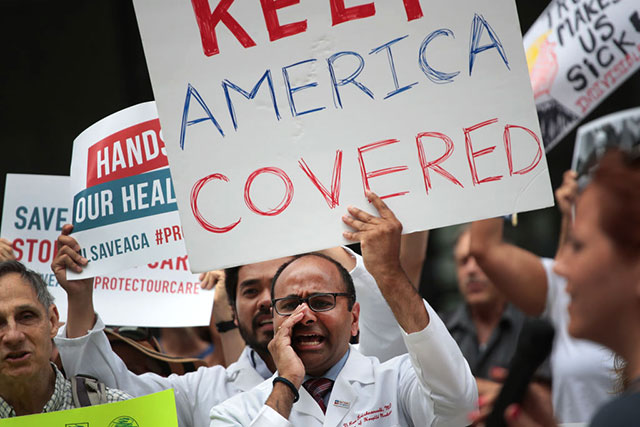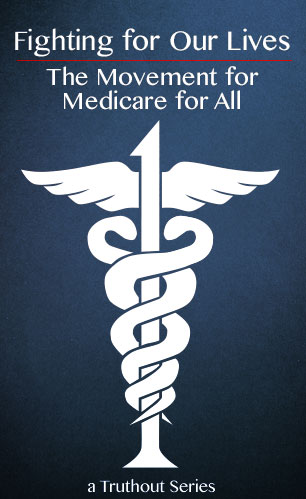
Part of the Series
Fighting for Our Lives: The Movement for Medicare for All
This piece is part of Fighting for Our Lives: The Movement for Medicare for All, a Truthout original series.
Never say congressional town halls lack power. Republican recipients of Obamacare and Medicaid are venting rage at their senators and representatives with turnouts in the hundreds in rural town halls and in the thousands in cities, expressing their displeasure at Republican efforts to revoke their health care through the passage of Trumpcare.
Democratic incumbents, by contrast, have been unnerved by rafter-ringing chants of “Single-Payer! Single-Payer!”
Town hall power drove terrified Senate Republicans to craft their version of the Trumpcare bill in secret and later to delay their scheduled vote on the bill.
To the shock and aggravated fury of many Republicans in Congress, thousands have showed up at meetings to express their rage about any effort to touch Obamacare or Medicaid. Even in rural districts, hundreds have showed up to give the what-for to House and Senate members even leaning toward the final Trumpcare bill.
High school gyms, rural or urban, have become powder kegs of opposition for Republicans. Tears of rage are not uncommon from those fearing they’ll lose Obamacare or recalling deaths of the underinsured or uninsured.
Medicaid recipients of both parties already know that Republicans are seeking to cut $834,000,000,000 from its budget. Meanwhile Obamacare enrollees will learn that Trumpcare will be more costly — five times more for those aged 50-64 — and its plans will be harder to find. There are more than 2,200,000 potential voters over 55 alone. In short, millions will have over a year to badmouth Republican House and Senate members supporting Trumpcare.
In view of the unlikelihood of Trumpcare becoming law, the dissatisfaction with Obamacare’s flaws and the precariousness of Medicaid, it’s high time for incumbents to disobey party leaders and launch a bipartisan single-payer bill.
Many Democrat Incumbents Haven’t Backed Conyers’s Bill
The many House Democratic incumbents who haven’t co-sponsored the Expanded and Improved Medicare for All Act, introduced in January by Rep. John Conyers (D-Michigan), have been silent or evasive about single-payer. The party policy was officially set at last year’s national convention in the platform committee meeting when the establishment junked Sen. Bernie Sanders’ single-payer amendment. So the party’s response to constituent demands for single-payer this year has been to tell voters that Democrats are going to fix Obamacare’s shortcomings, as Sen. Dianne Feinstein tried to do, to jeers at town halls in Los Angeles and San Francisco.
 Pelosi has declared single-payer will not be in the Democrats’ 2018 platform or, by implication, ever get to a floor vote in Congress. Incredibly, she insisted, “The comfort level with a broader base of the American people is not there yet.”
Pelosi has declared single-payer will not be in the Democrats’ 2018 platform or, by implication, ever get to a floor vote in Congress. Incredibly, she insisted, “The comfort level with a broader base of the American people is not there yet.”
It’s not?
A Pew research study reported that 60 percent of Americans are now demanding single-payer. Add to that the AP-NROC poll last December showing Americans’ No. 1 priority is health care, whatever their party registration: Democrats, 40 percent; Republicans, 47 percent; Independents, 43 percent.
Of even greater importance to incumbents and challengers has been Morning Consult/Politico’s April poll revealing 44 percent of the public wanted single-payer coverage: Democrats, 54 percent; Republicans, 35 percent; Independents, 42 percent.
Single-Payer Frees Businesses From Payroll Costs
Business owners know that single-payer would eliminate a major payroll expense — a median cost of $5,000 per employee for health coverage. Employers would also be spared annual premium hikes and fights over abortion coverage.
So how can Congressional leaders like Pelosi ignore the news in late May that the New York State Assembly passed a single-payer bill by a 92-52 vote?
New York’s program is expected to save enrollees significant expenses — it has no premiums, co-pays, deductibles — and patients can keep their doctors. It may save businesses a median 12.8 percent on payrolls. Estimations of savings to the state by disconnecting from insurance companies: $70,000,000,000.
Health Care Now reports that four other legislatures are working hard to pass single-payer bills: Massachusetts, Minnesota, Pennsylvania and Rhode Island.
Nevada’s legislature just passed a “Medicaid for All” bill, an end-run for the possibility that Trump succeeds in axing half of Medicaid’s participants; it’s also a gateway to a national single-payer program. The Nevada Care Plan permits the uninsured of any income level to enroll. If they’re in Obamacare, they can apply its tax credits to buy coverage.
In the Pacific Northwest, US Rep. Earl Blumenauer (D-Oregon) told us at his town hall that a regional single-payer health care plan is being fielded that would involve California, Oregon and Washington State in a West Coast Regional System to share costs and program administration. Legislators are also considering a bi-coastal risk pool of New York and California.
Voters Threaten to Oust Representatives Who Slash Health Care
The most unnerving chant to new House members has to be “It’s Your Last Term!” Voters in 2018 will remember incumbents failing to prevent bankruptcy from astronomical hospital bills and/or disabilities and preventable deaths. Obamacare has 11,300,000 participants, and Medicaid has 68,965,776. And even in a mid-year election most (and their families and contacts) may get out and vote.
Several House and Senate members have made fast retreats when interrogations became unbearable or have become no-shows at their own town halls. At least two House members — Mike Coffman, Tom McClintock — have fled through back-door exits. Even though Coffman was one of the 20 Republicans who voted against Trumpcare, he still faced shouting constituents eager to express their vehemence against Trump’s attack on their health care.
Florida’s Sen. Marco Rubio, a 2016 presidential candidate, made a quick trip to Europe and arrived home to find his photo on milk cartons (“Missing Senator. Afraid of constituents with tough questions”). He tried to outrun constituents with questions in Jackson at a hospital, in a parking garage, and a shouting pedestrian on the sidewalk. In Miami, he fled his class at Florida International University after 10 minutes of taunts (“You don’t care about our health care”). Then there was absenteeism at a standing-room-only citizen-called town hall in Tampa, where panelists held up his empty suit.
When Michigan’s Mike Bishop declined an invitational town hall, organizers similarly used a cardboard cutout of him so some of the 500 attendees could fire questions at “Flat Mike.”
Some Responses Are Illogical
Some lawmakers have given illogical, flustered, or downright ridiculous advice to constituents who are worried about losing Obamacare. For example, Idaho’s Raul Labrador drew hecklers and a chorus of raucous laughter with his now-famous statement, “Nobody dies because they don’t have access to health care.” Access, of course, is far different from actually getting care.
In Iowa, freshman Sen. Joni Ernst, crouched behind a massive desk, advised a 60-year-old man concerned about losing Obamacare to start a Health Savings Account with his disposable income. That preposterous, callous response earned thunderous jeers, yells and waving hands.
Word quickly spread that town halls were becoming combat zones for Republicans so that by the May recess, ThinkProgress reported only 20 of the 217 voting for Trumpcare’s first version were holding them.
Among them was Kansas’ Dr. Roger Marshall, who said the poverty-stricken “just don’t want health care and aren’t going to take care of themselves.” His comments provoked a hullabaloo that he compounded by declaring that such critics were “paid protesters” and “un-American” to boot.
New York’s Peter King and dozens of House cohorts have resorted to telephonic Q&As and have ordered staff members to delete even mildly adverse comments on their Facebook pages.
Health Care Industry Faces Losing Billions in Profits
Our lawmakers’ stubborn opposition to an overwhelming public demand for single-payer is not surprising given how much money they receive from the for-profit health industry.
The Open Secrets website shows that the health care industry spent over $480,000,000 on both parties and candidates in the 2016 election. A breakdown of recipients is revealing and both infuriating and heartbreaking.
The irony in all of this is that the industry is currently in flux about the potential loss of the usual billions in profits if the Republicans succeed at dismantling Obamacare and downsizing Medicaid. As a Politico writer noted:
Some major members of the sprawling trillion-dollar industry, like Humana and Cigna, have little at stake in the fight. Other insurers heavily invested in the Obamacare markets, like the regional Blue Cross Blue Shield plans, are urging Congress to fix the 2010 health law instead of shredding it. And then there’s Anthem, a rare industry voice supporting repeal.
The result is the lobby has lost influence and is now struggling to mount a unified front against Republican efforts to push through an Obamacare replacement. At the same time, the Trump administration has ignored their pleas to stabilize Obamacare’s exchanges in the short term, which could send the wobbly insurance marketplaces crashing before the GOP agrees on a health care plan.
Seasoned health care campaigners have suggested that an effective and efficient plan would be to target those 112 co-sponsors of Conyers’ Medicare for All bill and the 20 Republicans who voted against the Trumpcare bill with every kind of communication tool extant to urge a floor vote on the single-payer House bill (and a Senate companion bill) by late summer.
The message: It’s possible to disobey party leaders and stand for millions of Americans by voting for single-payer. Whether the legislation passes or not, incumbents backing a bipartisan bill could claim bragging rights for that vote in the 2018 campaign. Health campaigners could use this push to remind lawmakers that nearly 138,000,000 voters are in federal health care programs and may opt to vote for candidates supporting single-payer.
Senate’s Trumpcare Version May Take Months
This scenario is entirely possible in the next few weeks because the Trumpcare efforts appear to be moving slowly.
Indeed, Senate leader Richard Burr (R-North Carolina) said he doubts “Congress is going to reach a deal to repeal and replace Obamacare this year.”
If he’s right, there may be a priceless opportunity for a bipartisan, joint single-payer bill to move exceedingly fast in Congress — by Thanksgiving or Christmas — and gain enough votes to override a Trump veto and make it the law of the land.
We can get single-payer health care if a nationwide campaign begins right now to urge House and Senate members to disobey party leaders and endure losing the industry’s bribes. Incumbents should know that at least 128,000,000 voters await their actions on health care, and that those actions could decide the 2018 election’s outcome.